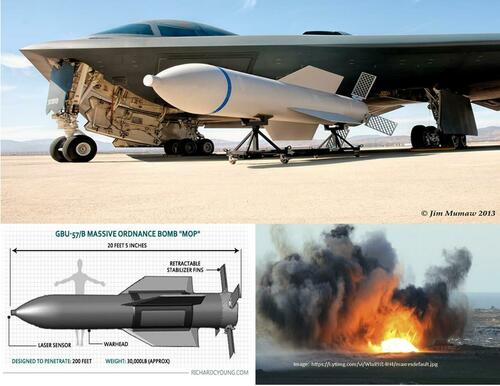America's 'Bunker-Buster' Bomb Production To Triple As World Fractures Into Dangerous Multi-Polar State
Munitions stockpiles are running low across the West, whether in Europe or the United States. Supplying Ukraine with arms in its war against Russia has forced Western militaries and defense firms to either make plans or begin boosting the production of bombs, missiles, artillery shells, and suicide drones.
On Tuesday, the US Air Force announced a tripling in its monthly production of the giant 30,000-pound Massive Ordnance Penetrator, known as the "bunker-buster." It's the largest non-nuclear bomb the US has in its stockpiles and can only be deployed by a Northrop Grumman B-2 Spirit stealth bomber.
Bloomberg was among the first to report an increase in bunker-buster bomb production, citing a USAF statement: "Will significantly increase production as needed."
Officials at the facility told Bloomberg journos during a March tour by General Charles Brown, chairman of the Joint Chiefs of Staff, that new bunker-buster bomb production could rise from currently two, to as many as six or possibly eight bombs per month.
The Oklahoma plant is being upgraded to support higher production of 2,000- to 30,000-pound bombs. A ribbon-cutting ceremony is scheduled for July 30, and production ramps are expected soon after.
Ukraine isn't the only conflict area draining Western supplies of munitions. The US has been supplying Israel with bombs and missiles as the conflict with Hamas rages on. And there's a further risk of broadening conflict in the region with Iran. Let's not forget China and the South China Sea.
Maiya Clark of the Heritage Foundation recently explained the US military-industrial complex can't just turn on a switch and produce more bombs:
"Once the stockpiles are expended, the Department of Defense cannot simply buy more munitions — manufacturing takes years."
Clark continued:
"Ramping up production after operating at a smaller capacity takes time; contractors have found that it will take them around two years to deliver new Javelins to the Department of Defense (DOD), for example."
She warned:
"This creates a problem in the present—after all, the war in Ukraine could continue for some time—and it illuminates what could potentially be a much larger problem in the future. The lack of surge capacity creates the risk that, in a protracted war, the US would deplete its stockpiled munitions before replacements could be manufactured and delivered."
This all plays into an important theme of soaring global military spending as the world fractures into a chaotic, multi-polar state. There's a bull market in defense.



